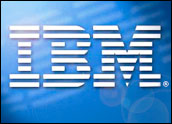
As IBM celebrates its centennial this year, the company is building technologies to take us into the future.
IBM’s Watson computer has pounded its human opponents on the game show “Jeopardy,” signaling huge improvements in the development of artificial intelligence and cognitive computing.
Meanwhile, Big Blue is working on a smarter planet initiative which aims to help cities use software and analytics to monitor and manage their power consumption using one interconnected infrastructure.
This will further add to the exploding demand for data, so another sector IBM is working on is data storage — with a technology it calls “race track memory.
100 Years and Counting
Many of the projects that will take us into the future are built on technologies developed earlier by IBM.
“We invented the first commercial hard disk drive, the relational database, the concept of SAN (storage area networking) storage, and 80 percent of the world’s smartphones contain our software,” Kerrie Holley, chief technology of global business services at IBM, told TechNewsWorld.
Formed in 1911 as the Computing Tabulating and Recording Corporation, IBM was renamed International Business Machines in 1924.
In 1956, IBM developed RAMAC, or Random Access Method of Accounting and Control. This was the first magnetic hard disk drive. It was the size of two refrigerators and consisted of 24 disks spinning at 1,200 RPM, supplying data at 100Kbps (kilobits per second).
Big Blue created the floppy disk 15 years later. Originally designed for mainframes such as IBM’s S/370, it kept shrinking in size, from 8 inches to 5 inches, then 3.5 inches, over the years.
In 1969, IBM Labs developed the magnetic strips on magstripe cards, accelerating the use of credit cards around the world, as well as the use of magstripe security devices.
In 1981, the company unveiled the PC, launching a multi-billion dollar industry.
Watson’s Work Isn’t So Elementary
One of IBM’s major projects for the future is cognitive computing, the field that made IBM’s Watson supercomputer a killer Jeopardy player.
“We have a computer system in Watson that can analyze language the way you and I think — the puns, subtleties and riddles — and provide a response in less than three seconds,” IBM’s Holley said. “This is unprecedented,” he added.
The technology used in Watson can sort through complex data and look at the nuances of meanings of data through associations, IBM’s Holley said. Watson’s software assigns each of several probable solutions to an issue a probability of correctness. The system only puts up a solution when the probability of that answer being correct reaches a certain predetermined level.
“Watson playing Jeopardy and earlier IBM supercomputers playing chess is just the glitzy stuff,” Rick Sturm, the founder and CEO of Enterprise Management Associates (EMA), told TechNewsWorld. “But Watson’s more significant than that — we’re heading into this brave new world where computers are going to have possibilities beyond what most people have dreamed of.”
For example, IBM has invested lots of money in autonomic systems where the software on a system is self-aware and self-correcting and is also aware of the various components making up the system, Sturm said.
Improving the Planet’s IQ
One of IBM’s major projects for the future is its Smarter Planet initiative, which the company launched in 2008. This was predicated on the world becoming more instrumented, interconnected and intelligent.
“We’ve done a lot of stuff around using computers to energize cities,” IBM’s Holley said. “The smarter planet is something we’ve been putting out into the marketplace because it’s part of our leadership in terms of forward thinking to understand what’s possible in terms of smarter systems for economic growth, sustained development and societal progress.”
The Smarter Planet initiative offers a “wide range of opportunities for improving transportation systems, education, food, water, using social media as part of real-world input,” Holley remarked.
Translation: Lotsa lotsa moolah to be made.
Racking and Stacking the Data
The smarter planet initiative will depend strongly on complex event processing (CEP) — where tons of both structured and unstructured data is gathered, processed and analyzed in real-time.
IBM is one of several players in the CEP arena. Its solution is InfoSphere Streams, a high-performance computing system that’s based on IBM’s System S stream computing technology.
Stream computing automatically reconfigures system resources to cope with workloads as needed. That’s the autonomic computing EMA’s Sturm was talking about.
CEP handles oodles of data, adding further to the skyrocketing demand for data storage. To cope with this demand, IBM is working on a new memory technology known as “race track memory.”
Race track memory devices slide magnetic bits back and forth along nanowire “racetracks,” packing data in a microchip in three dimensions. The microchip uses the spin of electrons to manipulate these magnetic bits, IBM’s Holley said.
Race track memory will be non-volatile, meaning the data will be retained even when the power is turned off. It makes for data storage densities far surpassing those of conventional hard disk drives.
“Data storage is a big thing we’re working on, and we think race track memory is the future of data storage,” IBM’s Holley stated.
However, “it may take a few years before this can be commercialized,” Holley added.





















































